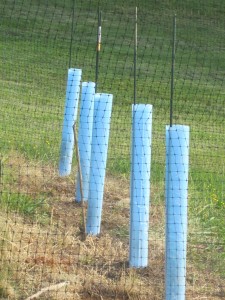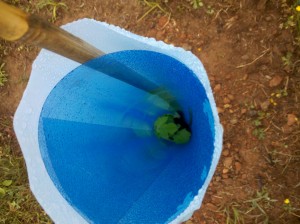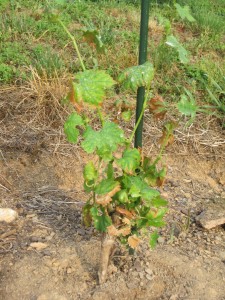Goodbye to Grow Tubes Forever!
Apparently there’s no agreed-upon rule book for viticulture.
When we planted Cab Franc vines on our Nelson County property, we followed the advice offered at a class on that very subject at the Piedmont Virginia Community College (great curriculum –the best available in Virginia today), and covered them with grow tubes. We
did the same for the two Mammolo Tuscano vines which we had received as a gift from Gabriele Rausse, one of the founding fathers of the Virginia wine industry and the instructor for a class on grafting.
At another class over the weekend, we were told, in no uncertain terms, to take them off. Sigh.
After doing a lot of overnight research, we decided that the grow tubes – ours are the so-called “Blue X,” which consist of a blue plastic insert and a soft-skin translucent blue sleeve – had to go. But it was kind of a close call.
A lot of the research we looked at suggested that while grow tubes provide a hot-house environment that jump starts the growth of the vines in their early months, they also prevent the vines from achieving their potential. The focus of the first two years is developing a strong trunk and root system. As Julien, the vineyard manager at DuCard Vineyards, told me, you must be willing to do the work, and to do it when it needs to be done. And you must be willing to be patient. The tubes, he added, rushed the process and created a hot-house that could cook the vines to death in the 90-plus degree weather we’ve been having.
My wife, the Vineyard Goddess (and future Vineyard Manager), took Julien’s words to heart and found a good deal of evidence to support the anti-grow tube proposition.
Research by the Southwest Michigan Research and Extension Center suggested that while vines in tubes faster in the early months, the height advantage disappeared by the end of
the season. More important, vines grown without tubes had more leaves and greater
leaf area. In addition, the total cane weight per vine was greater for vines grown without grow tubes, indicating that the tubes produce wood of substandard quality, which is likely
to have a significant impact on long-term survival and fruit quality potential. We found similar concerns expressed in Tony Wolf’s book, Wine Grape Production Guide for Eastern North America, the bible for East Coast viticulture.
Another problem, we realized, had to do with spraying. In Virginia, and most other viticultural areas, rain and humidity require regular spraying to prevent a variety of diseases, such as Powdery Mildew and Botrytis. Our vines were covered with 30” inch tubes when they were barely half a foot high. Since the leaves spread out across the entire diameter of the tube, getting the spray onto all of the leaves was next to impossible.
Making the decision to remove the tubes early wasn’t easy. We had been told that the tubes would force the vine to direct its energy toward producing a dominant shoot
that would emerge from the tube and become the trunk for the vine. We were also told that exposure to the sun’s UV rays after weeks inside the shelter of the tubes would kill all of the leaves except those that had already emerged from the tubes.
Some of the research we looked at suggested that if we removed the tubes late in the day, when the sun was lower in the sky, the vines would survive the afternoon and strengthen overnight. So, we waited until about 7 p.m., removed the tubes and tied the young vines to bamboo poles.
But the damage that the vines had sustained made us want to cry.
Most of the vines had at least some number of leaves that were brown and lifeless. Now we’re way too new to this enterprise to be able to diagnose the damage with any certainty.
It’s possible that leaves had turned brown and withered simply because of the tremendous heat generated in the mini greenhouses created by the tubes. Or perhaps it was because the spray hadn’t reached all of the leaves, and disease (Botrytis?) had taken hold.
We’ll find out soon enough, I suppose.
Well, ok, not that soon. The Vineyard Goddess and I are off to Sonoma this week to celebrate our 35th wedding anniversary by touring the Dry Creek and Russian River Valleys. So we’ll miss next weekend. But we’ll cross our fingers and hope for the best.
Interestingly, the vines we planted at home in Fairfax without use of grow tubes appear to be thriving. Of course, it’s hard to compare the two, since the terrain is so different. Long
term, I don’t have much hope for the Fairfax vineyard. The drainage is poor, and if a late spring frost doesn’t ruin them, then a deep winter freeze probably will.
But I have my grandfather’s optimism. He was a farmer who lived his entire life in Iowa, and no matter how bad the previous harvest had been, he approached every spring planting with joy and confidence. And so, I am certain that I will be making wine from these vines in three years. Of maybe four. No matter. The wine will come when it is ready.
In any event, it’s a learning experience. I’ll report back after we return from Sonoma.
Category: All Posts, Viticulture
Comments (6)
Trackback URL | Comments RSS Feed
Sites That Link to this Post
- A Tale of Two Vineyards, Part I (In which the origin of the Fairfax vineyard is described.) | Project Sunlight – A Winemaker's Education | June 14, 2011
- Grow Tubes Reconsidered | Project Sunlight – A Winemaker's Education | June 22, 2011
- Pruning and training first-year vines | Project Sunlight - A Winemaker's Education | June 8, 2012
- No Grow Tubes, No Round Up, No Sweat. (Well, maybe a little.) | Project Sunlight - A Winemaker's Education | July 10, 2012
- Shaped Blog | October 21, 2017






Thanks to Scott at DuCard Vineyards for evaluating the pictures of the vines and letting me know that it’s probably not disease, but a simple case of heat-fried leaves. I think I knew that, but when it comes to your children, you always fear the worst. If they sniffle, you worry that it’s the flu, and if they cough you diagnose it as pneumonia. Oh, well, my kids are grown. These vines are our new babies!